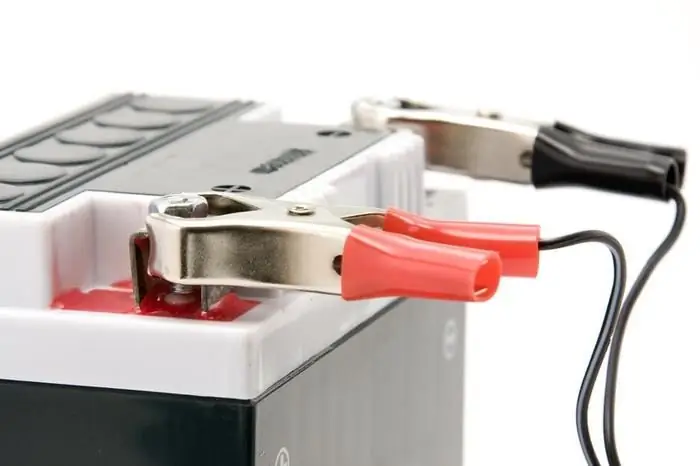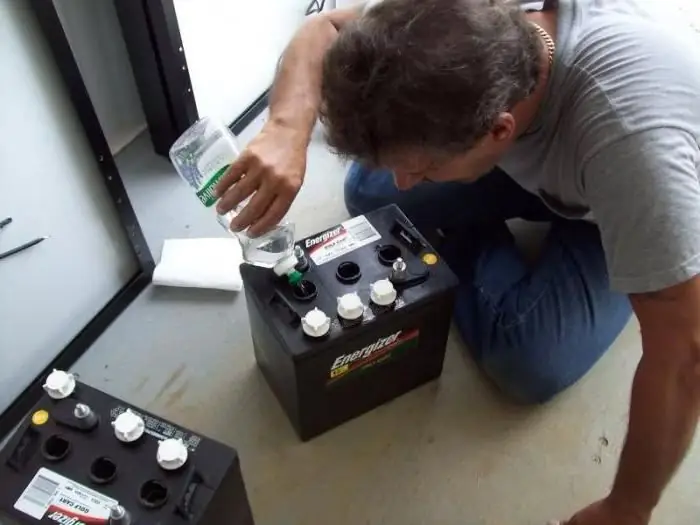2025 Author: Erin Ralphs | [email protected]. Last modified: 2025-01-22 21:14:11
What is the battery charging time? The degree of charge of the battery is judged by the density of the electrolyte. For the maximum charge, the indicator is 1.26-1.28 g / cm³. In this case, the voltage cannot be less than 12.5 V. It all depends on the initial indicator.
Important points
Battery charging time also depends on the season. For example, in the summer, a lead-acid battery is discharged by more than half, and in winter - only a quarter. Note that the rechargeable battery needs an additional charge, in the banks of which the density differs by more than 0.02 g/cm3.
The optimal indicator is the charging current of 0.1 of the maximum capacity. For a 55 Ah battery, this value is 5.5 A, and for a 60 Ah battery, it is 6 A.

Recharging methods
Car battery charging time depends on the method selected. The following options are currently used:
- DC;
- constant voltage.
Stages of battery discharge
The car battery charging time is determined by the formula:
T=Q/ I,
where Q is the full capacity of the battery, I is the value of the charging current, A. By substituting your indicators into the original formula, you can determine the time period that will be required to fully restore the lost capacity.
If you only need to partially restore the battery, then the battery charging time is significantly reduced.

Important points
To roughly estimate the time spent on charging a battery with direct current, you first need to calculate the degree of battery discharge (in percent), then you can calculate the lost capacity by selecting the size of the charging current.
The calculation formula is shown in the photo.
About 40-50% goes to efficiency, and the rest is spent on preheating, various electrochemical processes.

Application of the calculation formula
Charging should be accompanied by a periodic check of the process, so as not to miss the moment of the beginning of the boil. If for 60 minutes the voltage at the battery terminals does not change during charging, then the process is completed.
Final voltage parameters directly depend on temperature, charging current, battery resistance, lattice alloy composition, presence of impurities in the electrolyte.

Number of cycles
Each subsequent recharge of the battery degrades its working life. This also increases the time to fully charge the battery. It is determined by the formula:
Battery capacity / charging currentfactor
Moreover, the coefficient will depend on the specific situation:
- Battery charging takes about 4-20 hours. If the battery charging time is less than 4 hours, the charger should stop working automatically. The current decreases down to zero. Then you can remove the battery, start using it. If charging lasts more than 20 hours, then the current will not harm the battery.
- The capacity of the battery is indicated on the case. The units of measurement are mA / h, A / h (milliamp-hours, ampere-hours).
- The instructions must indicate the charging current. It is either displayed on the charger display or set manually.
Calculation example
How to determine the charging time of a 60A battery? How many minutes will it take to fully restore the battery? To answer this question, you need to know the following parameters: capacitance, current, average coefficient. For example, capacity - battery 1000 mAh, charger current - 150 mAh, coefficient - 1, 4. Determine the charging time:
(1000/150)1, 4=9.3 hours (9 hours 15-20 minutes)
This indicator is an average value. Recharging speed varies according to:
- temperature;
- initial charge;
- battery chemistry.

Battery Maintenance Rules
The main purpose of a battery in a vehicle is to start a car engine. In addition, the battery becomes an emergency power source if the generator fails. There are battery operation and maintenance requirements that every car owner should know.
It is recommended not to remove the battery from vehicles with the engine running. This in some cases can damage the integrity of the generator. Before removing the battery, in parallel with it, you need to turn on a 12 V incandescent lamp. In this case, the circuit will not open and the generator will not work on itself. Most of the batteries currently in production are lead-acid and use a double-sulfation variant.
This technology has existed since 1858, and is used in its original form today. True, in recent years, batteries for cars with an immobilized electrolyte have been produced to a greater extent. They are able to work in all spatial positions. The battery consists of a container in which there are six separate sections. In each section, independent energy generation takes place, and since there are plates, the electrolysis process is underway. The mass of the battery is 16-17 kilograms, it includes: electrolyte, lead plates, as well as additional connections.
How does a battery work? The principle of its work is very simple. There is dark brown lead oxide on the anode. On thecathode - spongy gray lead, inside - a solution of sulfuric acid (electrolyte). During the chemical reaction, the formation of zinc sulfate occurs, energy is released. No special action is required to service the battery.
There are four basic battery options, as follows:
- served;
- unattended;
- hybrid;
- low maintenance.
Let's talk about all varieties in a little more detail, since they are all used to some extent in everyday life and in technology.
- Serviced batteries are produced in small quantities, more often they are found in highly specialized industries. They have a high cost, unstable to temperature extremes. That is, at low temperatures, they can spontaneously discharge.
- Low-maintenance batteries are widely available, widely priced, reliable and durable.
- Maintenance-free batteries are suitable for those who do not want to spend effort on battery care.
- Hybrid batteries are expensive and rare. It is better to entrust the charging of batteries to professionals.
In order for the process of charging the battery to be safe, it is advisable to carry out such activities outside the living quarters. The fact is that when charging, hydrogen vapor is released, which can ignite. Therefore, it is strictly forbidden to charge the battery near open sources of fire.
Recommended:
Charging the battery: how many amps to put and how long to charge?

Some owners of their vehicles are interested in the question of how many amps to charge the battery? This is especially true for many beginners. After all, if you apply too much load, you can simply disable the battery
Proper battery charging tips and tricks

In the first autumn cold, it is necessary to prepare the car for winter. Moreover, this operation includes not only the installation of a winter set of tires. An important aspect is the battery. After all, the quality of starting a car depends on its condition. If you check the battery in time, you can eliminate problems such as poor starting of the engine or a complete discharge of the battery
Tesla car: range per charge in summer and winter, battery charging time

At the moment, the policy of many states is aimed at reducing the number of cars with gasoline and diesel engines. They should be replaced by cars on electronic traction. The most popular manufacturer of premium electric cars is Tesla, which will be discussed below
What to add to the battery - water or electrolyte? Car battery service. Battery electrolyte level

The main parts of the vehicle should include the battery. During normal operation, this battery is charged while the vehicle is running. But there are often cases when, if other devices in the car malfunction, it must be charged using a special device. Such operating conditions affect the rapid wear of the device. In addition, from time to time it needs to be refueled. Many people often get confused about what to add to the battery: water or electrolyte
When charging, the battery boils - is this normal or not? Find out why electrolyte boils when charging a battery

If your battery is boiling while charging and you don’t know if this is normal or not, then you can get all the information you need from this article. It also talks about how to properly charge the battery, and several other important nuances

